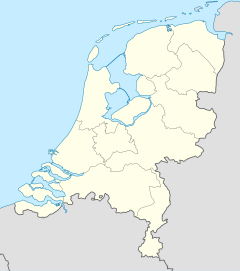Amersfoort concentration camp
| Kamp Amersfoort Polizeiliches Durchgangslager Amersfoort |
|
|---|---|
| Concentration camp | |

The watchtower of the camp
|
|
| Coordinates | 52°7′57″N 5°21′56″E / 52.13250°N 5.36556°ECoordinates: 52°7′57″N 5°21′56″E / 52.13250°N 5.36556°E |
| Other names | Polizeiliches Durchgangslager Amersfoort |
| Location | Amersfoort, Netherlands |
| Operated by | SS |
| Operational | 18 August 1941 19 April 1945 |
| Liberated by | transferred to Red Cross |
| Website | www |
Amersfoort concentration camp (Dutch: Kamp Amersfoort, German: Durchgangslager Amersfoort) was a Nazi concentration camp in Amersfoort, Netherlands. The official name was "Polizeiliches Durchgangslager Amersfoort", P.D.A. or Police Transitcamp Amersfoort. During the years of 1941 to 1945, over 35,000 prisoners were kept here. The camp was situated in the southern part of Amersfoort, on the city limit between Amersfoort and Leusden in central Netherlands.
Kamp Amersfoort in 1939 still was a complex of barracks that supported army artillery exercises on the nearby Leusderheide. From 1941 onwards, it didn't merely function as a transit camp, as the name suggests. The terms "penal camp" or "work camp" would also be fitting. During the existence of the camp many prisoners were put to work in kommandos. In total around 37,000 prisoners were registered at Amersfoort.
To get to the camp, prisoners had to walk from the railyard through the city and through residential neighborhoods:
Visible in the windows, above and below, of most residences and behind closed lace curtains, were numerous silhouettes, especially those of children. Usually the silhouettes did not move. Sometimes, feebly and furtively, they waved. Children who waved were very quickly pulled back. It was a farewell from the inhabited world -- now a realm of shades.
The history of the camp can be separated into two periods. The first period started on August 18, 1941 and ended in March 1943. In March 1943 all but eight of the first prisoners in Amersfoort were transferred to Kamp Vught. The prisoner transfer to Vught allowed for the completion of an expansion of Kamp Amersfoort. Maintaining the camp, despite Kamp Vught coming 'online' in January 1943, still appeared necessary to the Nazis.
Amersfoort was a transit camp, where prisoners were sent to places like Buchenwald, Mauthausen and Neuengamme. It was on July 15, 1942 that the Germans began deporting Dutch Jews from Amersfoort, Vught and Westerbork to concentration camps and death camps such as Auschwitz, Sobibor and Theresienstadt.
The remaining watchtower, as can be seen on the commemorative place, was built around April/May 1943, when the expansion of Kamp Amersfoort was completed and prisoners could be placed there again. In a lot of ways Kamp Amersfoort had changed relative to the first period. The most important changes were the much larger 'housing capacity', and the faster 'turnover'. What stayed the same, were the anarchy, the lack of hygiene, the lack of food, lack of medical attention and the cruelty of the guards. A point of light for the prisoners was the presence of the Dutch Red Cross. The second period ended on April 19, 1945, when control of the camp was transferred to Loes van Overeem of the Red Cross following the sudden flight of the German camp staff. The facility remained in operation under the auspices of the Red Cross until May 7, when Canadian soldiers of the First Canadian Army arrived to officially liberate the camp. Soldiers of I Canadian Corps fighting north from Arnhem were halted about a mile from Amersfoort before the end of the war, and liberation came on the day the German forces laid down their arms in the Netherlands. The camp and surrounding area was administered by the 1st Canadian Division and later transferred to the 3rd Canadian Division, Canadian Army Occupation Force in June 1945.
...
Wikipedia

